Most of us visit the Devalay to have a darshan of the Deity. In order to receive maximum Chaitanya (Divine consciousness), we must have the darshan in a spiritually correct manner. For this, Hindu Dharma has provided us with a set of guidelines based on shastras (scriptures). Many of us have some common queries regarding the spiritually correct manner of darshan in a Devalay. In the following article some of these common queries have been answered.
1. Why is entering the garbha-gruha (Sanctum sanctorum) prohibited?
Ordinary people cannot tolerate the Chaitanya emanating from the main energy flow of the Deity in the garbha-gruha and spreading all over; therefore, they are prohibited from entering the garbha-gruha.
The individual with a spiritual level of 50% has the ability to tolerate the Chaitanya emanating from the Deity and hence can enter the garbha-gruha.
2. What actions should be performed after having darshan of the Deity’s Idol?
A. There are two doors, one on each side of the garbhagar (Anteroom). After darshan of the Deity, come out through the door on the right side and have darshan of Agni Devta (Deity of Fire), that is, of the mandap (Hall) which has the yadnya kunda (Pit where yadnya [Ritual of sacrificial fires] is performed) (If it is there).
B. Then enter the garbhagar once again and come out of door on the left side and have darshan of the Idol of Deity Suryanarayan (If it is there).
C. Once again, enter the garbhagar, have darshan of the main Deity and come out of the main door of the garbhagar.
Science behind these actions
The sequence mentioned here is to have darshan of the main Deity first, followed by the darshan of Agni devta and Suryanarayan, and in the end, darshan of the main Deity again. The symbolic meaning of these acts is that, first approach the nirgun (Non-materialised) Principle, followed by sagun (Materialised) activity performed on the strength of the nirgun Principle, through the medium of the subordinate Deities (Agnidevta [who has Kshatratej (Radiance of a warrior class)] and Deity Suryanarayan [who has Brahmatej {Radiance of a Brahman, class which studies scriptures and imparts knowledge to the society}]); then in the end, dissolution in the original nirgun Principle. This is referred to as the ‘Doctrine of duality and non-duality’ or ‘one complete journey in the universe’. Through the entire journey of going from non-duality to duality and back to non-duality, God keeps working for the universe.
3. If the arrangement for pradakshina (Circumambulation) is not available in a Devalay, will it be correct to perform pradakshina around oneself?
In case a Devalay does not have an arrangement for pradakshina, then there is no need to perform one around yourself. However, during an Arati (A ritual of waving a lit lamp in front of a Deity and Saints, accompanied by singing of hymns), the nada-shakti (Sound energy) is activated and performing pradakshina around yourself helps derive the benefit of specific vibrations that arise from these sound waves. Hence, performing pradakshina around yourself only after the Arati is important.
4. What is the reason for not performing pradakshina in places like the samadhi (Mausoleum) of a Saint, Devalay of Navagraha and Sun Devalay?
Samadhi of a Saint, Devalay of Navagraha and Sun Devalay are the Shakti-peeths (Seats of Divine Energy), and hence as far as possible, avoid performing pradakshina around them. There exists a greater possibility of suffering distress when one performs pradakshina at places where only Shakti (Divine Energy) waves are accumulated. In the Devalay of superior Deities, since there is a harmonious cohesion of the sagun and the nirgun waves of Chaitanya, the possibility of experiencing distress by those having darshan is absolutely minimal.
5. Why is there a rule in some Devalays that males should remove their shirt before entering the Devalay?
Entering the garbha-gruha [Sanctum sanctorum of a temple] after removing the shirt laden with Raja-Tama predominant dust particles helps in imbibing sattvikta
To help in retaining the sattvikta of some Devalays where the Deity is in an awakened state or the Idol is Swayambhu (Self-originated), it is appropriate to remove the shirt laden with Raja-Tama predominant dust particles and only then enter the garbha-gruha, have darshan of the Deity and then offer puja objects. In such places therefore, only males are allowed inside the garbha-gruha. In any karma (act) the woman is a direct flow of supply of Shakti (Divine Energy), while the man is the doer in the form of Shiva. Therefore, it is important that he imbibes maximum of sattvikta. In karmakanda (Spiritual practice of rites, rituals and observances performed at the physical level) it is accepted that it is enough to wear minimum clothing consisting of cotton or silk around the waist and let the rest of the body be uncovered. This retains the purity of the ritual for a longer period and the worshipper gets the benefit of Chaitanya.
Reference : Sanatan Holy Text, ‘How should one have darshan in a temple?’


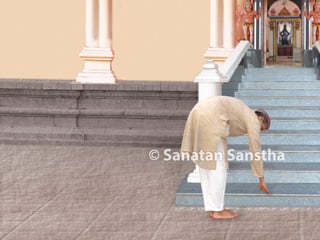 The correct method of having darshan in a Devalay (Temple)
The correct method of having darshan in a Devalay (Temple)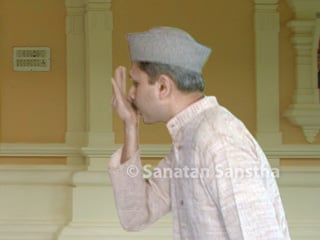 Partaking Tirth and Prasad
Partaking Tirth and Prasad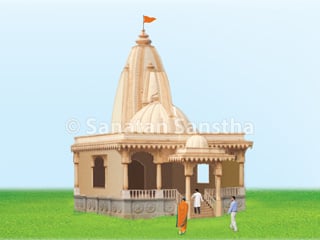 Importance of having darshan in a Devalay (Temple)
Importance of having darshan in a Devalay (Temple)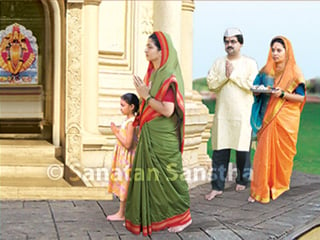 Performing Pradakshina (Circumambulation) of a Deity
Performing Pradakshina (Circumambulation) of a Deity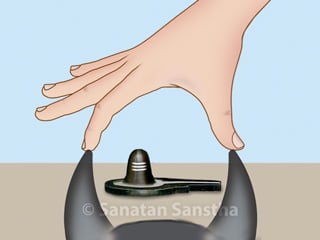 Importance of taking darshan of Nandi before darshan of the pindi in Deity Shiva’s Devalay
Importance of taking darshan of Nandi before darshan of the pindi in Deity Shiva’s Devalay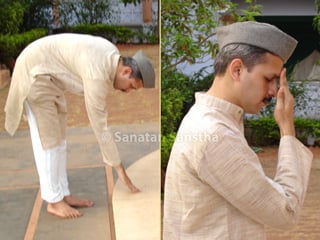 Visiting a Hindu temple - How to take benefits spiritually
Visiting a Hindu temple - How to take benefits spiritually